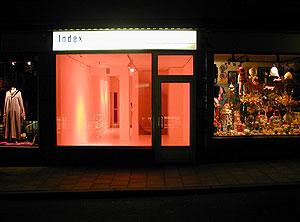Yoko Ono
dal 24/5/2002 al 9/6/2002
Segnalato da
24/5/2002
Yoko Ono
Index - the Swedish Contemporary Art Foundation, Stockholm
Sky TV from 1966 is one of the earliest video sculptures in the history of art and is Yoko Ono's only video work. The work has had considerable influence over the development of video art in recent decades. It is a conceptual work, executed through instructions: a video camera is aimed at the sky above the gallery and, via cable, plays the image on a TV inside the gallery.

Sky TV
Sky TV from 1966 is one of the earliest video sculptures in the history of
art and is Yoko Ono's only video work. The work has had considerable
influence over the development of video art in recent decades. It is a
conceptual work, executed through instructions, like many other of Ono's
productions: a video camera is aimed at the sky above the gallery and, via
cable, plays the image on a TV inside the gallery. At Index, Sky TV is
installed in the lounge designed by Luca Frei. Besides being a work in its
own right, Sky TV becomes a part of the flexible structure conceived by
Frei, serving as a three-dimensional work of historical reference.
Sky TV premiered at Yoko Ono's now legendary exhibition at the Indica
Gallery in London, 1966. Back then, there were no videotapes and TV
companies controlled all images for television. With Sky TV, Yoko Ono wanted
to prompt the viewer to think about how real TV is, by showing a real-time
image of the sky, which is less arranged (and mutilated), than the reality
offered by TV's recorded programmes.
Ono's work encourages several lines of association. In terms of the history
of art, one thinks for example, of Marcel Duchamp's Air de Paris (1919), a
small glass vial containing Parisian air (in 1967 Ono made her first work in
collaboration with John Lennon, Air Bottles, which can also be referred to
Duchamp). The Fluxus movement, of which Ono was a member, is also an
influence, mainly through its desire to establish a greater degree of
reality into art  and into the gallery space: a live broadcast! In
addition, Sky TV criticised its contemporary institutions, together with a
number of artists who oscillated between the reality outside and the gallery
space. Ono's work blurs the distinction between what is inside the gallery
and what exists outside. But of course, it is also about TV; about what is
broadcast and the way reality is filtered through television. It is a
criticism about TV that is no less relevant today (Sweden included) than the
context in which the work was first shown. Sky TV is related to Ono's and
Lennon's film Apotheosis (1970) and her Painting to See the Skies (1961), a
canvas with a hole through which a viewer sees the sky.
In recent years, one has been able to seriously appreciate the significance
of Yoko Ono's art. This has resulted, among other things, in the touring
retrospective Yes Yoko Ono. It opened in New York, October 2000, and then
toured in North America and Asia, and was even shown in Helsinki, Finland.
This summer, Sky TV, will appear as a large installation in Tokyo, featuring
no less than seventy television sets and fourteen cameras.
Also in the lounge is a reference copy of the Yes Yoko Ono exhibition
catalogue.
Opening, Saturday 25 May, 12 Â 4 p.m.
Index's exhibition, Changing Places, runs until 9 June.
Index- The Swedish Contemporary Art Foundation
S:t Paulsgatan 3, Box 151 52, 104 65 Stockholm
tel: 08-640 94 92, 08-640 60 69



